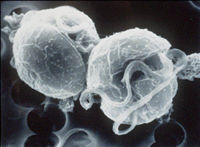What you should know about Pfiesteria and Virginia’s Waters
Who should I call if I see a fish kill or many fish with lesions?
Call the Department of Environmental Quality at (804) 698-4000 – Piedmont Region, (757) 518-2000 – Tidewater Region.
Who should I call if I suspect illness from Pfiesteria?
Call your physician, local health department, or the toll-free Pfiesteria Hotline at (888) 238-6154 (for Virginia residents only).
What is Pfiesteria?
 Pfiesteria is the name of a dinoflagellate. Pfiesteria is a microscopic organism that sometimes behaves like a plant and sometimes like an animal. Unlike other dinoflagellates that cause red and brown tides, Pfiesteria does not cause discoloration of the water. Pfiesteria has a complicated life cycle that includes a number of life stages. In a few of those stages it can produce a toxin that is harmful to fish. Pfiesteria toxin may also have negative effects on people. It has been associated with fish kills in the Neuse River in North Carolina and the Pocomoke River in Maryland and Virginia.
Pfiesteria is the name of a dinoflagellate. Pfiesteria is a microscopic organism that sometimes behaves like a plant and sometimes like an animal. Unlike other dinoflagellates that cause red and brown tides, Pfiesteria does not cause discoloration of the water. Pfiesteria has a complicated life cycle that includes a number of life stages. In a few of those stages it can produce a toxin that is harmful to fish. Pfiesteria toxin may also have negative effects on people. It has been associated with fish kills in the Neuse River in North Carolina and the Pocomoke River in Maryland and Virginia.
What are PLOs?
Research on Pfiesteria has led to other similar organisms being discovered. Scientists are still learning about these “close cousins” of Pfiesteria and have begun to call the whole group Pfiesteria-Like Organisms or PLOs.
Where else have PLOs been found?
They have been found as far south as the Gulf of Mexico and as far north as the Delaware Bay, most commonly in brackish (salty) water. To date, PLOs have been identified throughout the Virginia tributaries of the Chesapeake Bay.
Do PLOs affect humans?
A variety of symptoms have been reported from researchers who worked with Pfiesteria in North Carolina and from watermen in both North Carolina and Maryland. Medical teams from university medical schools have examined 39 persons from Maryland and 4 persons from Virginia who thought they had health effects from Pfiesteria. These watermen, recreational users and state employees described skin, digestive, respiratory and memory problems. After physical, laboratory and psychological testing, a similar problem with memory was observed in 13 Marylanders and 2 Virginians. There were no other known health problems to explain these abnormalities. Scientific studies are ongoing to confirm these findings and better define the human health effects from exposure to water in which PLOs release their toxin. Medical scientists are calling the health effects, “Estuary-Associated Syndrome”, since they do not know if it really is due to Pfiesteria.
Is it safe to eat seafood?
In general it is safe to consume seafood. As always, you should not eat fish or shellfish taken from areas where there are large numbers of sick or dead fish.
Is it safe to swim?
Swimming in areas where there are many dead fish is not recommended. Because toxins from PLOs are usually only present during a fish kill and then degrade and disappear quickly, swimming should be safe if at least 48 hours have gone by since a fish kill ended.
Is anybody looking for Pfiesteria in Virginia?
The Virginia Department of Health, the Virginia Department of Environmental Quality, the Virginia Institute of Marine Sciences, and Old Dominion University are all working together to monitor fish, water, and sediment samples from the Chesapeake Bay and its tributaries. The Virginia Department of Health urges local watermen, shellfish growers, commercial fisherman, and all citizens to report fish kills so that the cause of the fish kill can be determined.
Who should I call if I see a fish kill or fish with lesions?
Call the Department of Environmental Quality at (804) 698-4000 (Piedmont Region) or (757) 518-2000 (Tidewater Region).
Who should I call if I suspect illness from Pfiesteria?
Call your physician, local health department, or the toll-free HABs Hotline at (888) 238-6154 (for Virginia residents only).
